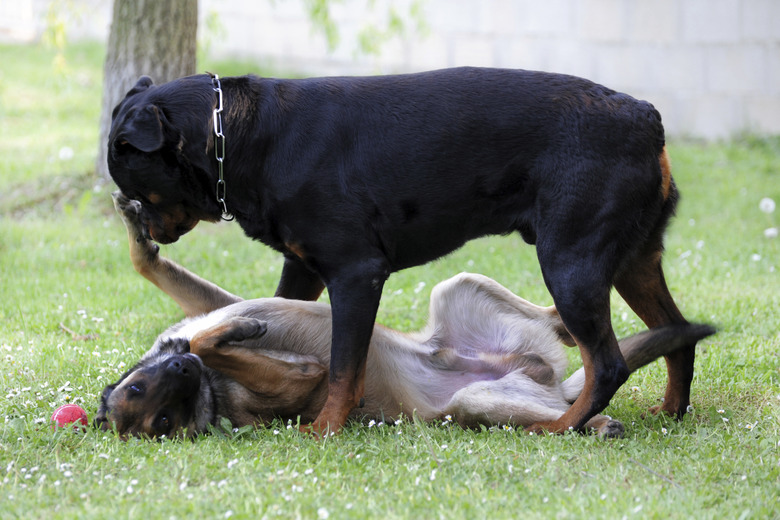Why Does My Dog Sit On Other Dogs?
Dogs are very expressive when it comes to body language, especially when they're feeling playful or snuggly. If your dog is sitting on another dog, it could be that he's feeling either of these things. However, your dog sitting on another dog could also be a more serious type of communication.
Security in numbers
Security in numbers
When your dog was a puppy, he no doubt snuggled together with his littermates for warmth, security, and comfort. It's not unusual for puppies to sleep in mounds atop one another and continue the practice into adulthood. This is common when siblings remain together into adulthood.
It's not unusual for the behavior of one dog sitting on the other dog to happen when both animals are calm and relaxed. One dog might lie down for a nap only to have the other sit down on her. If both dogs are nonchalant about the behavior, it's no cause for concern. Rather, it's a sign that your dogs are getting along well in the multi-dog household according to All Boxer Info.
If your dog is a puppy sitting on an adult dog, this feeling of warmth and security is very likely the reason he's creating a puppy pile. Unless the dog on the bottom shows signs of annoyance or aggression, the practice is normal and harmless according to Precision K9.
Part of the game
Part of the game
Another common situation where dogs sit on one another is during play. Running, rolling, jumping, and then sitting down on top of one another are all natural activities when your dog is playing.
Although play can incorporate lots of growling, barking, and nipping, it's pretty easy to tell when your dog is playing and not being aggressive. Roughhousing is normal and natural, according to Kanine Social, even when it involves growling, wrestling, or even sitting on one another.
Recognize the signs of aggression to know whether your dog sitting on another dog is a sign of play or something more sinister:
- Tense body with rigid muscles
- Baring teeth in a snarl, frequently followed by snapping the teeth
- Staring at the other dog without looking away
Is it dominant behavior?
Is it dominant behavior?
A dog sitting on another dog or even on its owner is sometimes automatically mistaken for a sign of dominant behavior. To know whether this is the case, it's important to be able to read your dog's other body language.
Although a dog will whine, bark, or make other sounds, verbalization is not the primary way dogs communicate. Dogs use facial expressions, posture, ear positions, and other body language, according to the American Kennel Club (AKC).
Look at your dog's eyes. Are they soft and relaxed, or hard and staring intently? The tail can be another indicator of your dog's intentions. A tail held high up over the back as it approaches the other dog instead of in a relaxed position can be an indicator of dominance. Keep in mind that some dog breeds such as chows have a tail that naturally curls over the back, so it's important to know what your dog's tail position is when it is relaxed.
Finally, some breeds are more prone to the behavior than others. Boxers and Great Danes are two large breeds that enjoy cuddling with both their own kind and their owner, so it's not unusual to find them sitting on another dog or even your lap.
